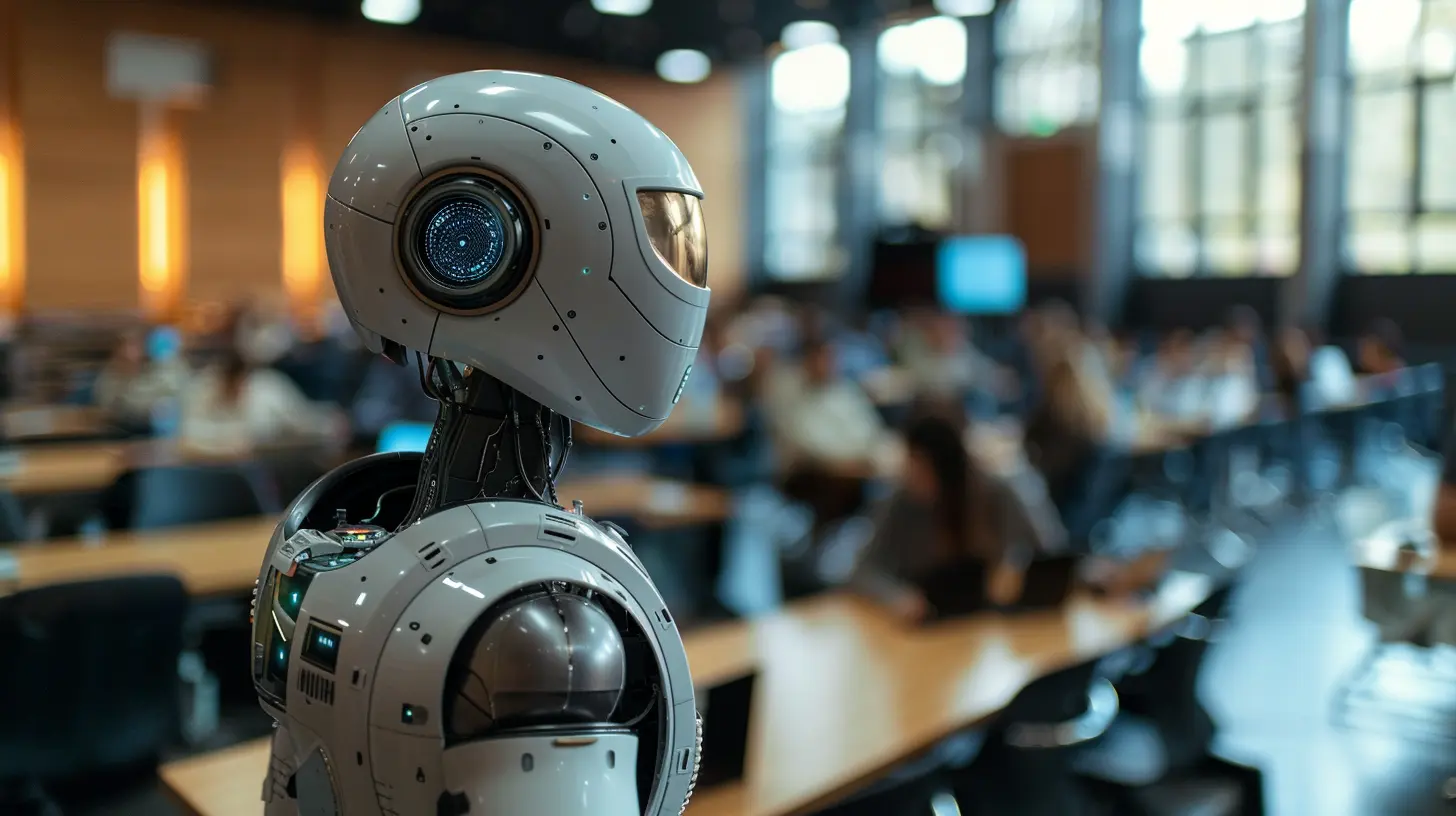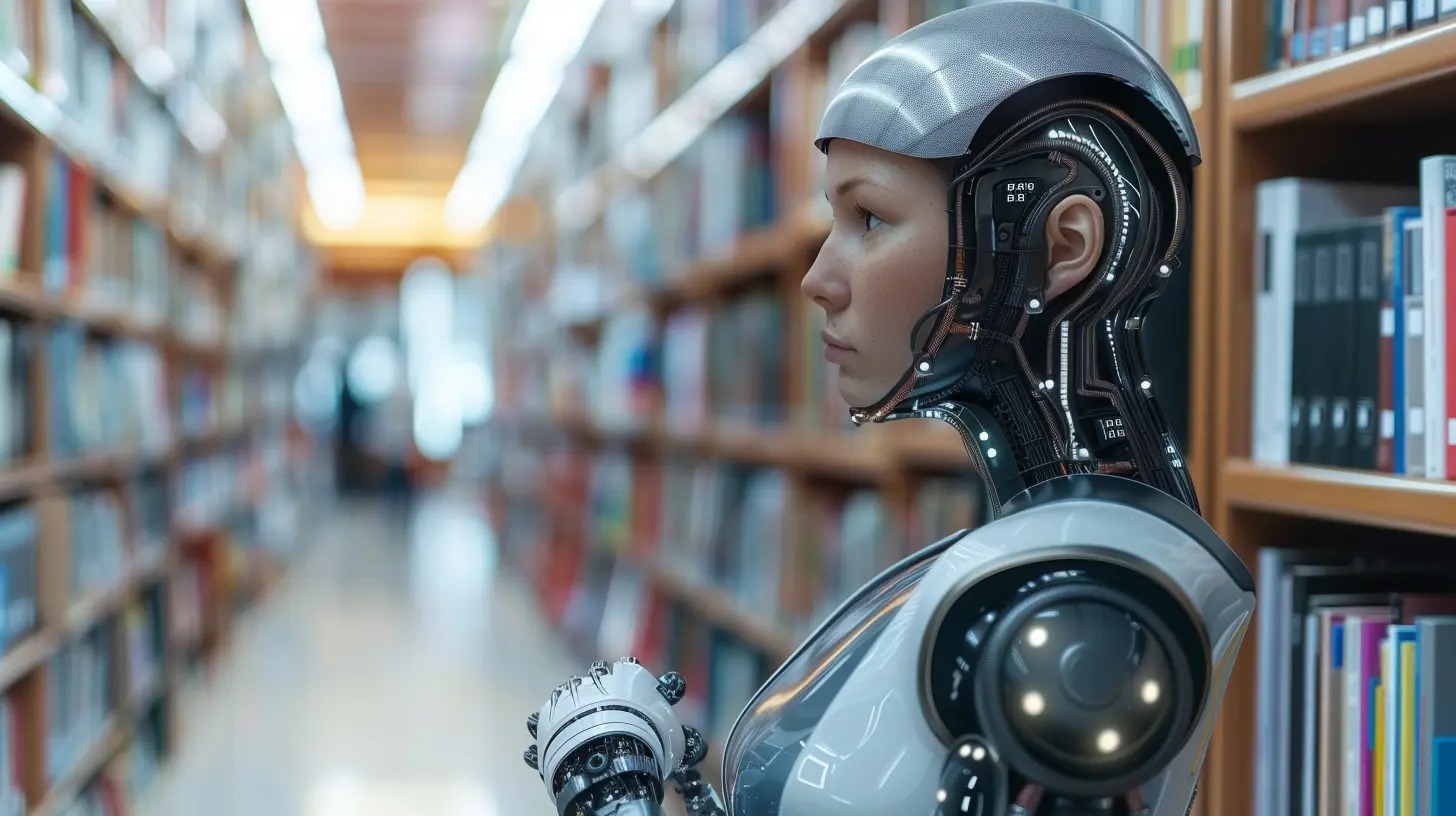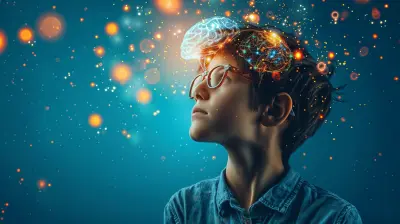Exploring the Role of Artificial Intelligence in Modern Classrooms
26 November 2024
Artificial Intelligence (AI) has already made its mark in various industries, but have you ever stopped to think about how it’s transforming the modern classroom? From personalized learning experiences to intelligent tutoring systems, AI is reshaping education as we know it. Gone are the days when classrooms were simply chalkboards and textbooks. Today, we’re stepping into a world where algorithms, machine learning, and digital tools are becoming just as important as a good old-fashioned No. 2 pencil.
But how exactly is AI making its way into our schools, and what role does it play in shaping the future of education? Let’s dive into the fascinating world of AI in education and uncover how it’s changing the game for students, teachers, and even parents.

What is Artificial Intelligence in Education?
Before we jump into the details, let’s first break down what Artificial Intelligence actually means in an educational context. AI refers to computer systems or machines that mimic human intelligence. They can think, learn, and even adapt to new information, just like humans. In education, AI is used to automate tasks, analyze data, and provide personalized learning experiences. It’s like having a super-smart assistant in the classroom that never gets tired!Imagine a teacher who knows exactly what every student needs and can instantly adjust the curriculum to meet those needs. Sounds too good to be true, right? Well, with AI, that dream is becoming a reality. Whether it’s through virtual tutoring, grading automation, or even virtual reality experiences, AI is stepping up as a game-changing tool in modern classrooms.

How AI is Revolutionizing the Learning Experience
Personalized Learning
Let’s face it: not every student learns at the same pace. Some grasp concepts quickly, while others need a little more time and attention. Traditionally, teachers have had to create one-size-fits-all lesson plans, which may not always cater to individual learning needs. Enter AI.AI-powered tools can analyze a student's performance, learning style, and areas of difficulty. Based on this data, they can create customized learning paths, providing lessons and exercises that are tailored to each student’s unique needs. Think of it as having a personal tutor, but one that’s available 24/7 and doesn’t require any extra fees!
For example, platforms like DreamBox and Knewton use AI algorithms to adapt lessons in real-time. They track how well a student is grasping a concept and adjust the difficulty level or provide additional resources as needed. This means no more falling behind in class or feeling like the material is moving too fast.
Intelligent Tutoring Systems
Remember those late-night study sessions where you were stuck on one math problem for hours? AI is now coming to the rescue with intelligent tutoring systems. These systems are designed to provide extra help outside of traditional school hours.AI tutoring platforms like Carnegie Learning and TutorMe use machine learning to offer step-by-step guidance on specific problems. They can explain concepts in different ways, give hints, and even quiz students to ensure they’ve fully understood the material. It’s like having a tutor who’s always available, ready to explain things in a way that makes sense to you.
And the best part? These AI tutors can adjust their teaching style based on how the student responds, ensuring a more personalized experience. No more frustration over not understanding a topic—AI tutors are there to help whenever you need them.
Automated Grading
If you’ve ever wondered how teachers manage to grade hundreds of papers without losing their minds, AI might have a lot to do with it. Automated grading systems are becoming increasingly popular, saving teachers hours of time and effort.AI can now grade multiple-choice quizzes, essays, and even more complex assignments. It doesn’t just check for correct answers; it can evaluate the quality of written responses, grammar, and even the depth of understanding. Tools like Gradescope and Turnitin use AI to provide instant feedback, allowing students to improve their work before submitting the final version.
This not only speeds up the grading process but also frees up more time for teachers to focus on lesson planning, engaging with students, and providing more meaningful feedback.

Enhanced Classroom Management with AI
AI-Driven Classroom Assistants
Imagine having a classroom assistant who can handle everything from taking attendance to managing classroom behavior. Sounds futuristic, right? Well, AI-powered assistants are already making their way into classrooms to help teachers with everyday tasks.Tools like Classcraft and GoGuardian use AI to monitor student behavior, participation, and even online activity during class. They can send alerts to teachers if a student is disengaged or off-task, allowing for real-time intervention. This helps teachers maintain control of the classroom without constantly micromanaging students.
Smart Content Creation
We all know that creating educational content—whether it’s lesson plans, quizzes, or assignments—can be a time-consuming process. AI is now stepping in to simplify this task, too. With AI-powered tools, teachers can generate quizzes, tests, and even reading material automatically based on the curriculum.Platforms like Content Technologies and Querium use AI to create "smart content" that adapts to the needs of both students and teachers. These systems can pull from vast databases of educational resources to generate customized content, saving teachers hours of preparation time.
But it doesn’t stop there—AI can even create virtual simulations and interactive lessons that make complex subjects like physics or chemistry more engaging. Think about it: instead of reading about chemical reactions, students can experience them in a virtual lab!

Addressing Challenges and Concerns
Teacher and Student Roles
One of the biggest concerns when AI enters the classroom is the fear that it will replace teachers. But let’s set the record straight—AI is not here to take jobs. Instead, it’s designed to assist and enhance what teachers are already doing. Teachers are irreplaceable when it comes to providing emotional support, fostering creativity, and offering personalized guidance that goes beyond what a machine can do.AI can handle mundane tasks like grading and data analysis, but it can’t replicate the human connection that’s so vital in education. Think of AI as a co-pilot in the classroom, helping teachers navigate through the complexities of managing diverse student needs, while still allowing them to focus on what they do best—teaching.
Privacy and Data Security
Of course, with great power comes great responsibility. One of the key concerns with AI in education is privacy and data security. AI systems collect a vast amount of data on students, including their academic performance, behavior, and even personal information. This raises valid concerns about how this data is used and who has access to it.Educational institutions and AI providers must ensure that student data is protected and used ethically. This includes implementing strict data security measures and being transparent about how the information is used. Having clear policies in place will help ease concerns and ensure that AI is used as a tool for good, rather than an invasion of privacy.
The Digital Divide
While AI has the potential to revolutionize education, it’s important to recognize that not all students have equal access to these technologies. The "digital divide" refers to the gap between students who have access to modern technology and those who don’t, often due to socioeconomic factors.For AI to truly make a difference, schools and governments must work to ensure that all students have access to the necessary tools, whether it’s a laptop, reliable internet connection, or AI-driven educational platforms. Only then can we fully realize the benefits of AI in education.
The Future of AI in Classrooms
So, where do we go from here? The potential for AI in education is enormous, but we’re really just scratching the surface. As AI technology continues to evolve, we can expect even more innovative applications in the classroom.One exciting area of development is the use of AI-powered virtual reality (VR) and augmented reality (AR) tools. Imagine stepping into a virtual classroom where you can explore historical events, conduct science experiments, or even visit distant planets—all from the comfort of your desk. These immersive experiences could make learning more engaging and interactive than ever before.
Another area to watch is the development of AI-driven emotional intelligence tools. These systems could analyze a student’s emotional state and provide tailored support to help them cope with anxiety, stress, or other challenges that impact their learning.
The future of AI in classrooms is bright, but it’s essential to strike a balance between embracing technology and preserving the human elements that make education so special. After all, no matter how advanced AI becomes, it will never replace the creativity, empathy, and passion that teachers bring to the table.
Conclusion
Artificial Intelligence is playing an increasingly significant role in modern classrooms, from personalized learning paths to automated grading and intelligent tutoring systems. While there are challenges, such as data security and the digital divide, the benefits far outweigh the drawbacks. With AI as a powerful tool in education, we can create more personalized, engaging, and efficient learning experiences.As AI continues to evolve, the classroom of the future may look very different from the one we know today—but one thing remains certain: the role of the teacher, supported by AI, will always be at the heart of education.
all images in this post were generated using AI tools
Category:
Educational TechnologyAuthor:

Anita Harmon
Discussion
rate this article
18 comments
Cruz Henderson
While the integration of AI in classrooms offers innovative learning opportunities, it's crucial to address ethical implications and equity disparities. AI should enhance personalized education without replacing the human touch that fosters critical thinking and creativity. Striking the right balance will determine its true effectiveness in shaping future learners.
February 10, 2025 at 7:54 PM

Anita Harmon
Thank you for your insightful comment! I completely agree that while AI can enhance personalized learning, maintaining a balance with human interaction is essential for fostering critical thinking and creativity. Addressing ethical implications and equity is vital for achieving effective integration in education.
Dahlia Pace
This article provides valuable insights into how AI can enhance classroom learning experiences. By integrating AI tools, educators can personalize learning, streamline administrative tasks, and foster collaboration. It would be beneficial to include case studies or examples of successful AI implementations in schools for a deeper understanding.
February 1, 2025 at 12:35 PM

Anita Harmon
Thank you for your thoughtful comment! I appreciate your suggestion for including case studies and examples; they would indeed enrich the article and provide practical insights into successful AI implementations in education.
Ava Ruiz
This article effectively highlights the transformative potential of artificial intelligence in education. The insights provided on enhancing personalized learning and streamlining administrative tasks are particularly valuable. I appreciate the thoughtful exploration of both benefits and challenges, which fosters a well-rounded understanding of AI's role in modern classrooms.
January 29, 2025 at 5:25 AM

Anita Harmon
Thank you for your thoughtful feedback! I'm glad you found the discussion on AI's potential in education valuable and well-rounded.
Sari Ramirez
Great insights on AI in education! Embracing technology can truly enhance learning experiences and empower both teachers and students alike.
January 24, 2025 at 7:48 PM

Anita Harmon
Thank you! I'm glad you found the insights valuable. Embracing AI can indeed transform education for everyone involved.
Wesley Thornton
Embracing AI in modern classrooms opens up endless possibilities for personalized learning and engagement. By integrating technology thoughtfully, educators can empower students to explore their potential, foster creativity, and prepare them for a dynamic future. Let’s advocate for innovative teaching methods that inspire and transform the educational landscape!
January 20, 2025 at 7:41 PM

Anita Harmon
Thank you for your insightful comment! Embracing AI indeed paves the way for transformative learning experiences and prepares students for the future. Let’s continue advocating for innovative educational practices!
Chelsea McKenzie
This article brilliantly highlights AI’s potential in education! I'm intrigued by how these technologies could enhance learning experiences and personalize education. Looking forward to discovering more about their practical applications!
January 18, 2025 at 7:23 PM

Anita Harmon
Thank you for your enthusiasm! I'm glad you found the article insightful. AI truly has the potential to transform education, and I look forward to sharing more about its practical applications in future pieces!
Andrea Barnes
Embrace AI for student success!
January 17, 2025 at 5:06 AM

Anita Harmon
Absolutely! Embracing AI can enhance personalized learning, streamline administrative tasks, and provide valuable insights to support student success.
Susan McAleer
Transformative tool for educators.
January 15, 2025 at 5:34 AM

Anita Harmon
Thank you! I believe AI can significantly enhance teaching and learning experiences.
Nymira Lambert
AI in classrooms: It’s like having a super-smart sidekick that never needs snack breaks! Just imagine, less 'Why is this happening?' and more 'Let’s make learning a breeze!' 🍎🤖
January 11, 2025 at 5:04 AM

Anita Harmon
Absolutely! AI can enhance learning experiences by providing instant support and personalized guidance, making education more engaging and efficient. 🍎✨
Vera Bell
In classrooms bright with digital light, AI dances, a partner in flight. Crafting minds with tailored care, Knowledge blooms in the electric air. From data’s depth to dreams that soar, Together, we unlock learning’s door— A future where potential knows no shore.
January 5, 2025 at 12:12 PM

Anita Harmon
Thank you for capturing the essence of AI's transformative role in education! Your poetic perspective highlights how technology can enhance personalized learning and expand possibilities for all students.
Everett Russell
This article raises fascinating questions about AI in education! How exactly does AI enhance personalized learning experiences, and what are the implications for educators? I'm curious about the balance between tech and human interaction in classrooms—can AI truly complement traditional teaching methods effectively? Looking forward to more insights!
January 2, 2025 at 1:05 PM

Anita Harmon
Thank you for your thoughtful comment! AI enhances personalized learning by analyzing student data to tailor content and pacing, thus allowing for differentiated instruction. While it can complement traditional methods, the balance between tech and human interaction is crucial; effective integration can enhance engagement without replacing the invaluable role of educators. I appreciate your interest and will delve deeper into these topics in future discussions!
Piper Perez
Exciting insights on AI in classrooms!
December 29, 2024 at 3:35 AM

Anita Harmon
Thank you! I'm glad you found the insights exciting. AI has incredible potential to enhance learning experiences!
Otis McTier
AI is revolutionizing education by personalizing learning experiences, enhancing engagement, and equipping students with essential skills for the future. Embrace this transformation!
December 20, 2024 at 5:07 AM

Anita Harmon
Thank you for your insightful comment! I completely agree that AI's role in personalizing education and preparing students for the future is transformative and essential.
Alexia McBride
Thank you for this insightful article! It wonderfully highlights the transformative potential of AI in education. As we integrate these technologies into modern classrooms, it's crucial to consider both the benefits and ethical implications, ensuring that we enhance learning while fostering an inclusive and equitable environment for all students.
December 15, 2024 at 8:49 PM

Anita Harmon
Thank you for your thoughtful comment! I completely agree—balancing innovation with ethical considerations is key to maximizing AI's benefits in education.
Kiera McFarlane
Empowering teachers, enhancing learning.
December 4, 2024 at 7:37 PM

Anita Harmon
Thank you! Empowering teachers with AI tools truly enhances the learning experience for students, making education more effective and personalized.
Uma Lambert
AI in classrooms: a double-edged sword. It can personalize learning and streamline tasks, but let’s not forget—technology should enhance, not replace, the irreplaceable human touch in education. Balance is key!
November 30, 2024 at 4:51 AM

Anita Harmon
Thank you for your insightful comment! I completely agree—AI can enhance education, but maintaining the essential human connection is vital for meaningful learning experiences. Balance truly is key!
Gianna Bass
AI transforms learning; embrace the future!
November 28, 2024 at 8:15 PM

Anita Harmon
Thank you! Embracing AI in education indeed opens new avenues for personalized and effective learning experiences.
Sawyer McIntire
Great article! I appreciate how you've highlighted the potential of AI to enhance learning experiences and personalize education. It's exciting to think about the future of classrooms with these advancements. Thank you for sharing!
November 27, 2024 at 1:58 PM

Anita Harmon
Thank you for your kind words! I’m glad you found the article insightful. The future of AI in education is indeed promising!
MORE POSTS

How to Write an Engaging Blog Post

Leadership for Equity: Addressing Disparities in Education

Collaborative Learning with Open Educational Resources

The Role of Extracurricular Activities in Preventing Bullying

Writing in Different Genres: Exploring New Styles

Developing Resilience in Students Through Problem Solving

Time Management Advice for Graduate Students

The Power of Positive Reinforcement in Special Education

The Link Between Problem Solving and Lifelong Learning

Self-Assessment: A Key to Unlocking Autonomous Learning

Learning to Say No: Protecting Your Time in Busy Academic Life